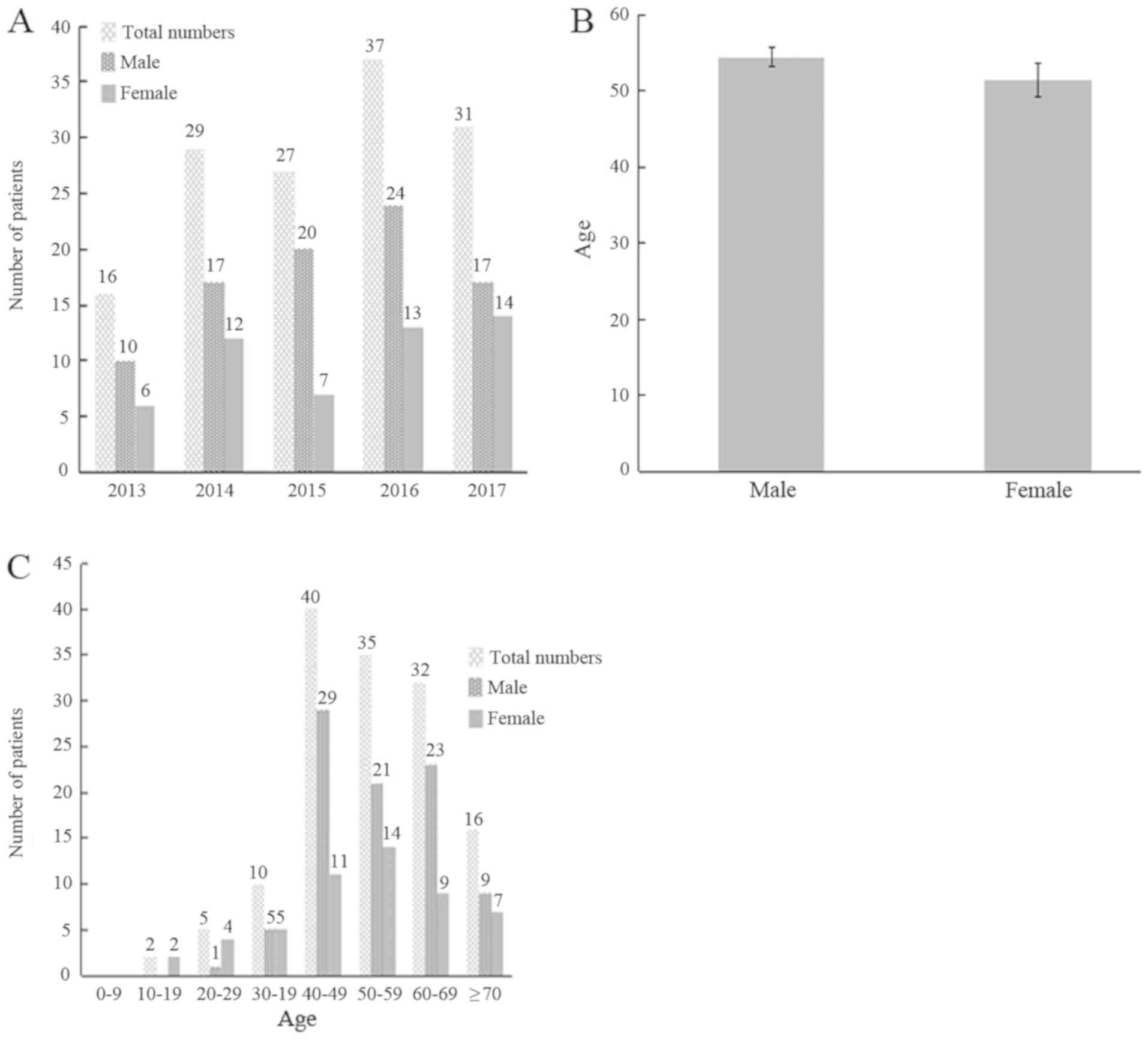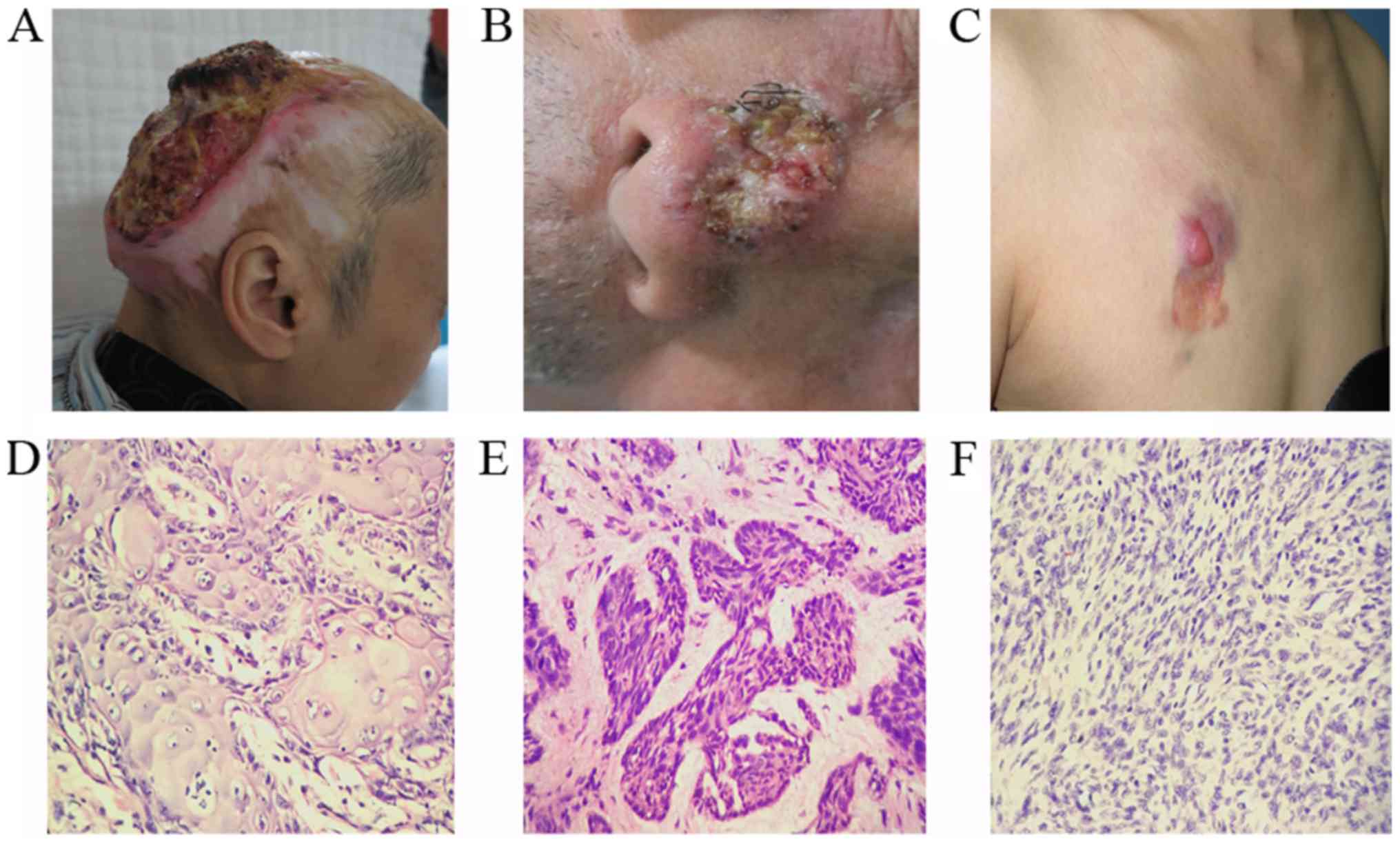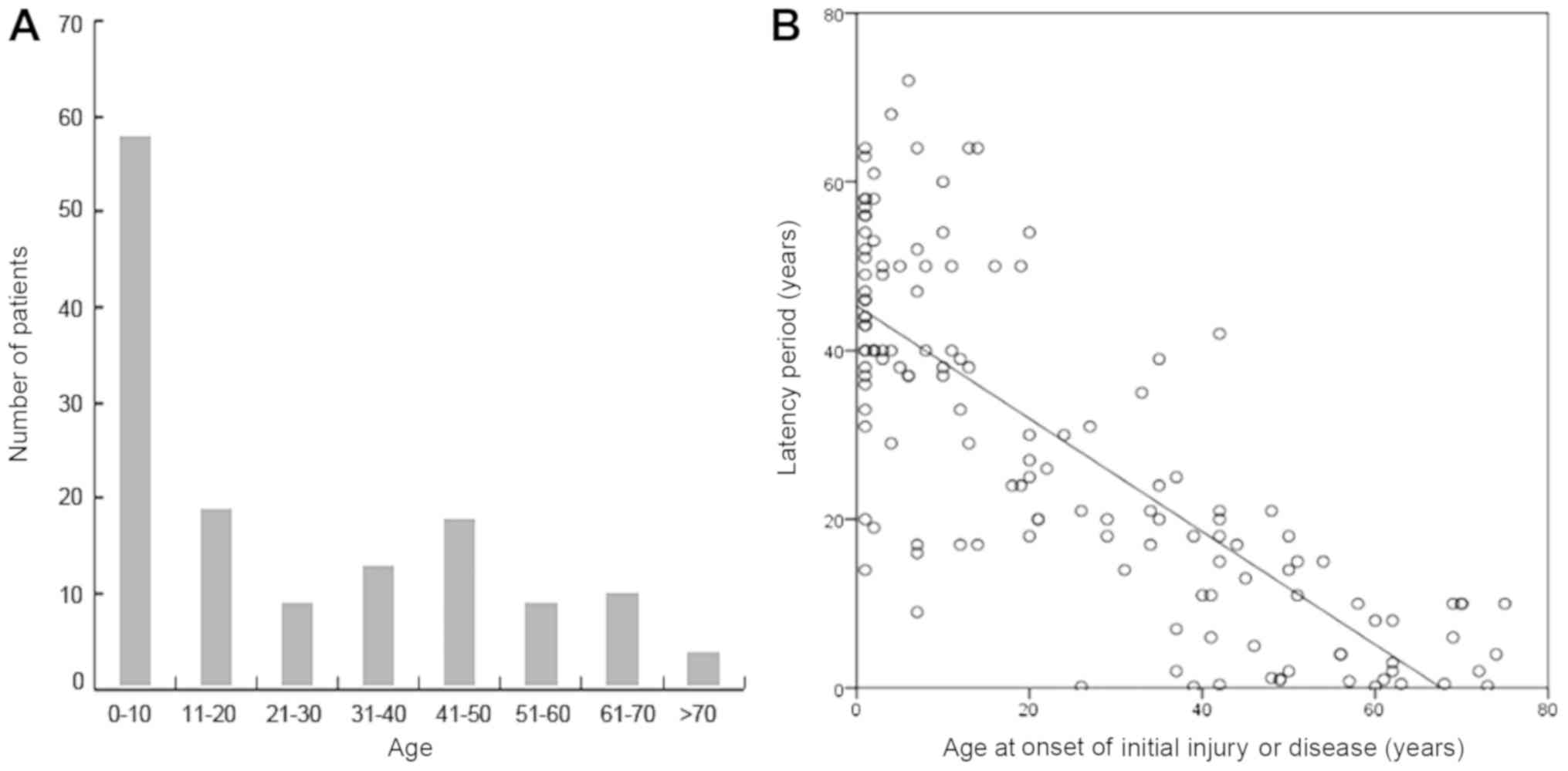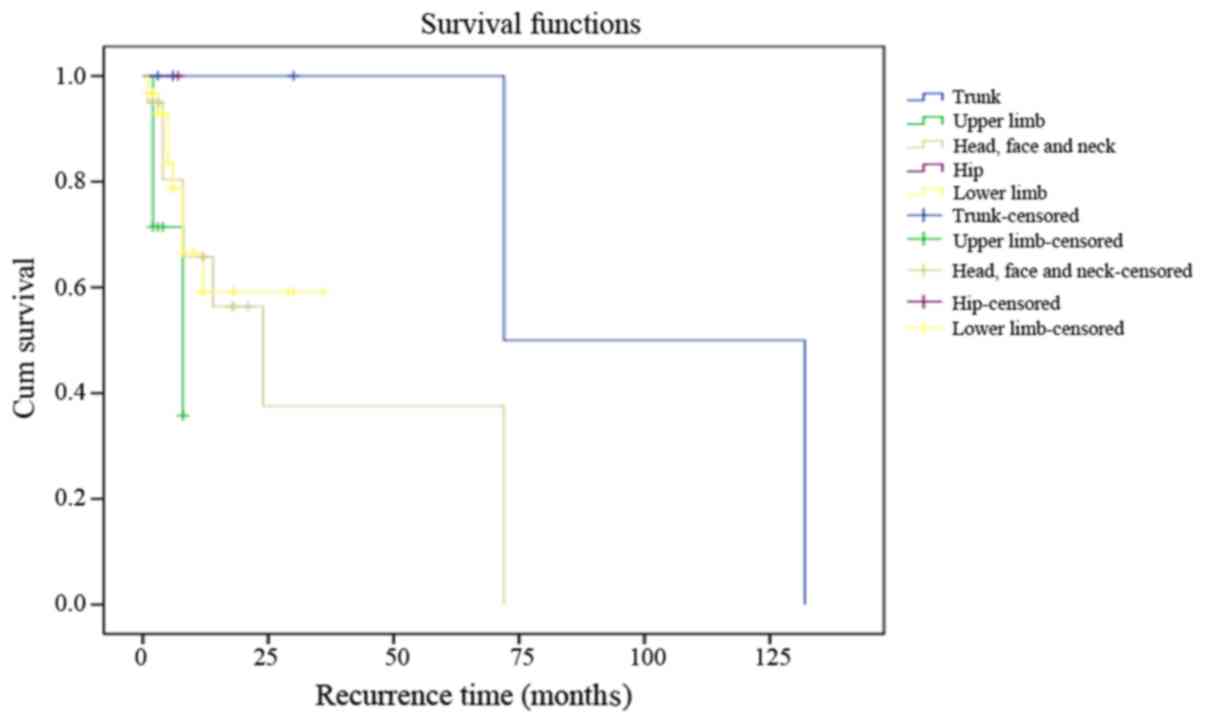|
1
|
Onesti MG, Fino P, Fioramonti P, Amorosi V
and Scuderi N: Ten years of experience in chronic ulcers and
malignant transformation. Int Wound J. 12:447–450. 2015. View Article : Google Scholar : PubMed/NCBI
|
|
2
|
Das KK, Chakaraborty A, Rahman A and
Khandkar S: Incidences of malignancy in chronic burn scar ulcers:
Experience from Bangladesh. Burns. 41:1315–1321. 2015. View Article : Google Scholar : PubMed/NCBI
|
|
3
|
Hahn SB, Kim DJ and Jeon CH: Clinical
study of Marjolin's ulcer. Yonsei Med J. 31:234–241. 1990.
View Article : Google Scholar : PubMed/NCBI
|
|
4
|
Chalya PL, Mabula JB, Rambau P, Mchembe
MD, Kahima KJ, Chandika AB, Giiti G, Masalu N, Ssentongo R and
Gilyoma JM: Marjolin's ulcers at a university teaching hospital in
Northwestern Tanzania: A retrospective review of 56 cases. World J
Surg Oncol. 10:382012. View Article : Google Scholar : PubMed/NCBI
|
|
5
|
Pekarek B, Buck S and Osher L: A
comprehensive review on Marjolin's ulcers. Diagnosis and treatment.
J Am Col Certif Wound Spec. 3:60–64. 2011.PubMed/NCBI
|
|
6
|
Bazaliński D, Przybekmita J, Barańska B
and Więch P: Marjolin's ulcer in chronic wounds-review of available
literature. Contemp Oncol. 21:197–202. 2017.
|
|
7
|
Kheiri B, Osman M and Al Hadidi S: From a
burn scar to malignancy! Marjolin's ulcer, a disease of wound
neglect. Oxf Med Case Reports. 2018:omy0442018. View Article : Google Scholar : PubMed/NCBI
|
|
8
|
Nthumba PM: Marjolin's ulcers: Theories,
prognostic factors and their peculiarities in spina bifida
patients. World J Surg Oncol. 8:1–5. 2010. View Article : Google Scholar : PubMed/NCBI
|
|
9
|
Liu Z, Zhou Y, Zhang P, Zhang M, Ren L,
Zeng J, Zhou J, Liang P and Huang X: Analysis of clinical
characteristics of 187 patients with Marjolin's ulcers. Zhonghua
Shao Shang Za Zhi. 32:293–298. 2016.(In Chinese). PubMed/NCBI
|
|
10
|
Sisti A, Pica Alfieri E, Cuomo R, Grimaldi
L, Brandi C and Nisi G: Marjolin's ulcer arising in a burn scar. J
Burn Care Res. 39:636–639. 2018.PubMed/NCBI
|
|
11
|
Fishman JR and Parker MG: Malignancy and
chronic wounds: Marjolin's ulcer. J Burn Care Rehabil. 12:218–23.
1991. View Article : Google Scholar : PubMed/NCBI
|
|
12
|
Altunay I, Cerman AA, Sakiz D and Ates B:
Marjolin's ulcer presenting with in-transit metastases: A case
report and literature review. Ann Dermatol. 27:442–445. 2015.
View Article : Google Scholar : PubMed/NCBI
|
|
13
|
Choi JY, Bae YC, Nam SB and Bae SH: Impact
of disturbed wound healing after surgery on the prognosis of
Marjolin's ulcer. Arc Plast Surg. 40:198–202. 2013. View Article : Google Scholar
|
|
14
|
Aydogdu E, Yildirim S and AkSz T: Is
surgery an effective and adequate treatment in advanced Marjolin's
ulcer? Burns. 31:421–431. 2005. View Article : Google Scholar : PubMed/NCBI
|
|
15
|
Jellouli-Elloumi A, Kochbati L, Dhraief S,
Ben Romdhane K and Maalej M: Cancers arising from burn scars: 62
cases. Ann Dermatol Venereol. 130:413–416. 2003.PubMed/NCBI
|
|
16
|
Fazeli MS, Lebaschi AH, Hajirostam M and
Keramati MR: Marjolin's ulcer: Clinical and pathologic features of
83 cases and review of literature. Med J Islam Repub Iran.
27:215–224. 2013.PubMed/NCBI
|
|
17
|
Shen R, Zhang J, Zhang F, DU Y, Liang W,
Xu L, DU X, Chen P and Chen X: Clinical characteristics and
therapeutic analysis of 51 patients with Marjolin's ulcers. Exp
Ther Med. 10:1364–1374. 2015. View Article : Google Scholar : PubMed/NCBI
|
|
18
|
Yu N, Long X, Lujan-Hernandez JR, Hassan
KZ, Bai M, Wang Y, Wang X and Zhao R: Marjolin's ulcer: A
preventable malignancy arising from scars. World J Surg Oncol.
11:3132013. View Article : Google Scholar : PubMed/NCBI
|
|
19
|
Fernandes MG, Brandão M and Dias EM:
Marjolin's ulcer with axillary lymph node metastasis. Acta Med
Port. 31:5152018. View Article : Google Scholar : PubMed/NCBI
|
|
20
|
Dupree MT, Boyer JD and Cobb MW:
Marjolin's ulcer arising in a burn scar. Cutis. 62:49–51.
1998.PubMed/NCBI
|
|
21
|
Ozek C, Celik N, Bilkay U, Akalin T, Erdem
O and Cagdas A: Marjolin's ulcer of the scalp: Report of 5 cases
and review of the literature. J Burn Care Rehabil. 22:65–69. 2001.
View Article : Google Scholar : PubMed/NCBI
|
|
22
|
Bozkurt M, Kapi E, Kuvat SV and Ozekinci
S: Current concepts in the management of Marjolin's ulcers:
Outcomes from a standardized treatment protocol in 16 cases. J Burn
Care Res. 31:776–780. 2010. View Article : Google Scholar : PubMed/NCBI
|
|
23
|
Opara KO and Otene IC: Marjolin's ulcers:
A review. TNHJ. 11:107–111. 2011.
|
|
24
|
Onah II, Okwor B and Onuigbo WI:
Penetrating scalp Marjolin's ulcer involving bone and dura mater in
a Nigerian hospital: Case report and literature review. Burns.
36:e39–e43. 2010. View Article : Google Scholar : PubMed/NCBI
|


















